Chilli Paneer is a popular Indo-Chinese appetizer featuring soft paneer cubes stir-fried with a zesty, spicy sauce, crisp bell peppers, onions, and aromatic spices. This dish has become a staple at Indian-Chinese restaurants and street food stalls, winning hearts with its bold flavors and mouth-watering texture.
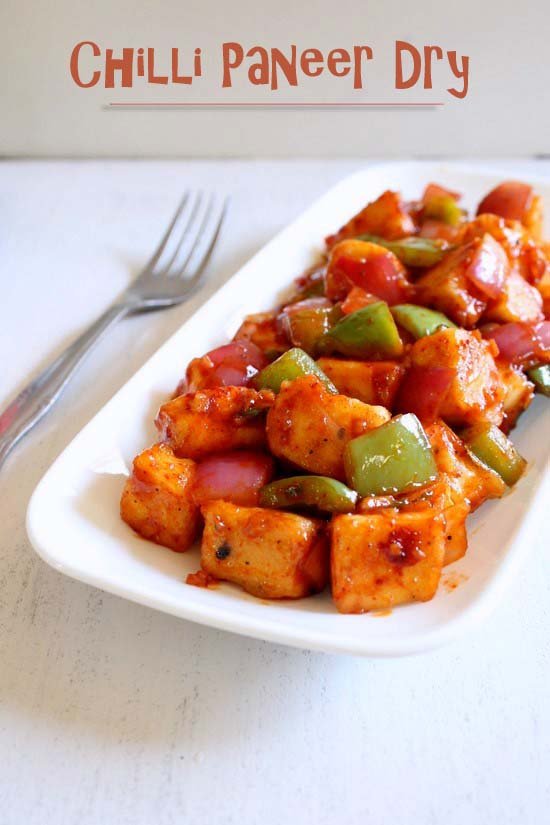
Every time we dine at an Indo-Chinese eatery, this dish is one of our must-orders, right alongside crispy sesame honey chilli potatoes. The combination of crispy paneer, the crunch of sautéed vegetables, and the zingy seasoning makes it irresistible. A few weeks ago, I decided to try recreating this popular dish at home, and to our delight, it turned out just as good, if not better!
What makes dry chilli paneer stand out is the perfect balance of heat, tanginess, and umami, all wrapped around golden-fried paneer cubes. It’s not overly saucy like the gravy version, but it has just enough coating to hold the intense flavors together. The dry version is ideal as a starter or a snack and goes incredibly well with a hot cup of chai or as part of a larger Indo-Chinese meal.
Whether you’re cooking for guests or want to indulge in a homemade treat, this dish delivers both in taste and texture. It’s surprisingly easy to make with a few pantry staples, and once you try it, there’s a good chance it will become a regular feature in your kitchen.
There’s also a saucy, gravy-based version of chilli paneer that pairs beautifully with fried rice or noodles—and I’ll be sharing that recipe soon. But for now, let’s dive into the dry version that’s all about crispy bites and bold flavor.
Ingredients for Chilli Paneer:
For Frying Paneer:
- 200 grams paneer, cut into cubes: Choose firm, fresh paneer and slice it into evenly sized medium cubes to ensure they cook uniformly and hold their shape during frying. This forms the base of the dish, absorbing all the delicious flavors during cooking.
- 2 tablespoons All-Purpose Flour (Maida): This helps create a light coating around the paneer, giving it a crispy outer layer when shallow-fried.
- 1 tablespoon Corn Flour (Cornstarch): Corn flour adds a crisp texture to the paneer and helps bind the flours together while frying.
- ¼ teaspoon Black Pepper Powder: A dash of freshly ground black pepper gives a subtle heat and depth to the marination.
- Salt, to taste: Modify the quantity according to your taste, but remember that soy sauce also contributes saltiness to the dish.
- 1 teaspoon Soy Sauce: Adds a rich umami flavor and deepens the taste of the paneer coating. Use dark or light soy sauce based on your flavor preference.
- 3 tablespoons Water: Water helps create a smooth batter to evenly coat the paneer cubes before frying.
- 1–2 tablespoons Oil, for shallow frying: Use a neutral oil for shallow frying the paneer until golden and crispy on all sides.
Rest Ingredients:
- 1 tablespoon Oil: Use a neutral oil like sunflower or canola. It helps sauté the aromatics and veggies, unlocking their flavor.
- 2 teaspoons Garlic, finely chopped: Fresh garlic brings a bold, savory base. Chopping it finely helps it mix seamlessly into the sauce, enhancing the overall flavor.
- 2 teaspoons Ginger, finely chopped: Ginger adds a gentle heat and aroma. Finely chopped pieces release more flavor quickly while cooking.
- 2 Green Chilies, finely chopped: These add a spicy kick. Adjust to your heat preference and deseed if you want it milder.
- ½ cup Red Onion, cut into chunks: Red onions add a mild sweetness and crunch. Larger pieces retain texture during cooking.
- ½ cup Green Capsicum, chopped into chunks: Bell peppers offer color, crunch, and a subtle sweetness that complements the spices.
- 1 teaspoon White or Rice Vinegar: Vinegar adds a sharp tang that enhances the signature Indo-Chinese flavor profile.
- 1 tablespoon Soy Sauce: Gives a rich umami flavor. Choose between light or dark soy sauce as per your taste.
- 2½ tablespoons Tomato Ketchup: Ketchup balances the heat with its sweet and tangy notes.
- 1 tablespoon Chili Sauce: Provides the dish’s spicy element. Adjust the amount according to your preferred level of spiciness.
- Salt, to taste: Add sparingly, as soy sauce and ketchup already contain salt.
- ¼ teaspoon Black Pepper Powder: A dash of black pepper adds warmth and sharpness to round off the flavors.
Step-by-Step Instructions for Making Chilli Paneer:
1) Begin by preparing the batter. In a bowl, combine all-purpose flour, corn flour, salt, black pepper powder, and soy sauce.
2) Slowly pour in 3 tablespoons of water, stirring until you achieve a thick and smooth batter.

3) Gently add the paneer cubes into the batter.
4) Toss carefully so that each piece of paneer gets evenly coated with the batter.
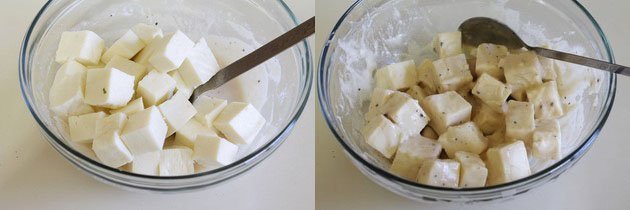
5) Heat about 2 tablespoons of oil in a non-stick pan over medium heat. Once the oil is hot, add the coated paneer cubes for frying.
6) Fry the paneer until the underside turns a light golden brown, then carefully flip to cook the other sides evenly. Once all sides are golden and crisp, remove the paneer onto a plate and set aside.
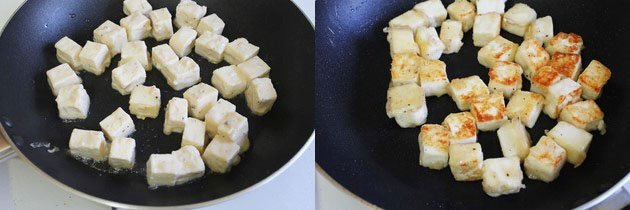
7) As the paneer rests, get the sauce mixture ready. Combine soy sauce, tomato ketchup, chili sauce, and vinegar in a small bowl and stir until fully incorporated.
8) Stir the sauce ingredients well and keep aside for later use.
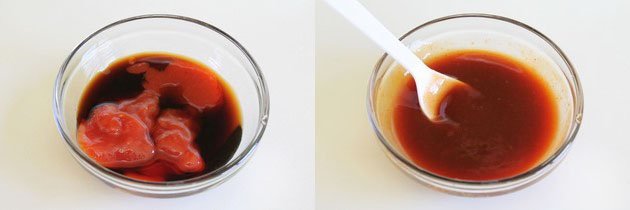
Make Chilli Paneer :
9) Using the same pan, heat the remaining oil over medium heat. When hot, add the finely chopped garlic, ginger, and green chilies.
10) Sauté these aromatics for 1 to 2 minutes until their raw aroma disappears.
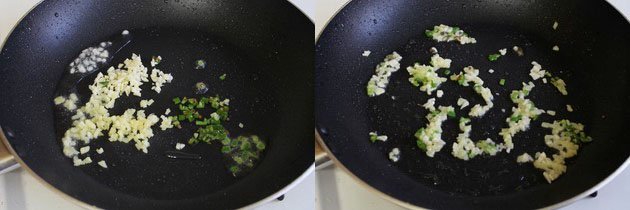
11) Add the chunked onions and cook for 2 minutes, allowing them to soften slightly.
12) Next, add the chopped green capsicum and sauté for 2 minutes. The peppers need to stay crisp and tender, avoiding being overcooked.
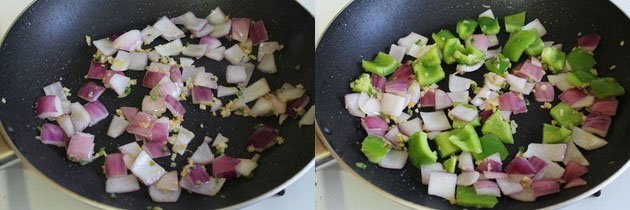
13) Pour in the prepared sauce mixture along with salt and black pepper to taste.
14) Stir well and allow the sauce to heat through.
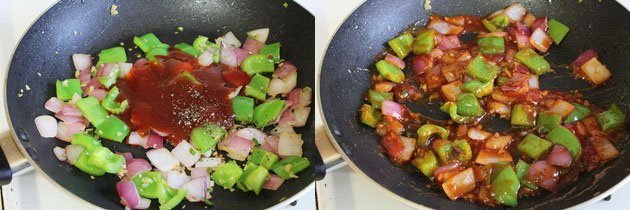
15) Add the fried paneer pieces back into the pan.
16) Toss everything gently to coat the paneer evenly with the sauce and allow it to heat through completely. Once done, turn off the heat.
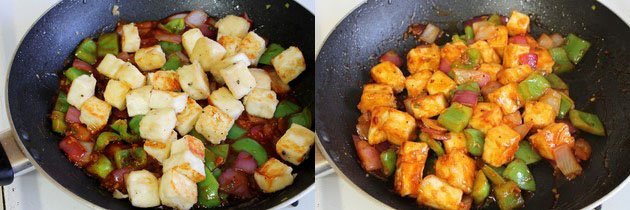
Transfer the chilli paneer to a serving plate and serve immediately. If available, garnish with the green parts of chopped spring onions for added freshness. (I skipped this step as I didn’t have any on hand.)
Serving suggestion for Chilli Paneer:
Serve this delicious dry chilli paneer as a flavorful starter to kick off your Indo-Chinese meal. It also pairs wonderfully as a side dish with fried rice or noodles, making it perfect for lunch or dinner. You can even wrap it in a roti or stuffed paratha for a spicy paneer roll, or serve it as an appetizer at parties and get-togethers to impress your guests with its bold flavors and vibrant presentation.
Expert Tips:
1) Healthier Cooking Option: In this recipe, I’ve chosen to shallow-fry the paneer, which uses less oil and makes it a healthier option. However, if you’re aiming for that truly indulgent, restaurant-style flavor and texture, deep-frying the paneer will give you the crispiest and most satisfying results.
2) Uniform Cutting for Better Presentation: While chopping the vegetables and paneer, try to cut everything into uniform, bite-sized cubes. Keeping the paneer and vegetables the same size not only helps with even cooking but also enhances the dish’s overall appearance. Though not essential for taste, it certainly improves the visual appeal when served.
3) Keep the Veggies Slightly Undercooked: For any Indo-Chinese dish, maintaining the crunch of the vegetables is key. The onions and bell peppers should be sautéed just enough to take the raw edge off but still remain slightly firm. Overcooked veggies will make the dish lose its signature texture.
4) Pre-mix the Sauces: To streamline the cooking process and avoid overcooking the vegetables, it’s best to prepare your sauce mixture ahead of time. Measuring and mixing all the sauces in a bowl beforehand will save time and ensure that your onions and peppers stay crisp instead of turning soggy while you fumble with sauce bottles.
5) Add a Splash of Color with Bell Peppers: For a more colorful and visually appealing version of chilli paneer, consider adding red and yellow bell peppers along with the green ones. They not only enhance the dish’s look but also bring a subtle sweetness that balances out the spiciness beautifully.
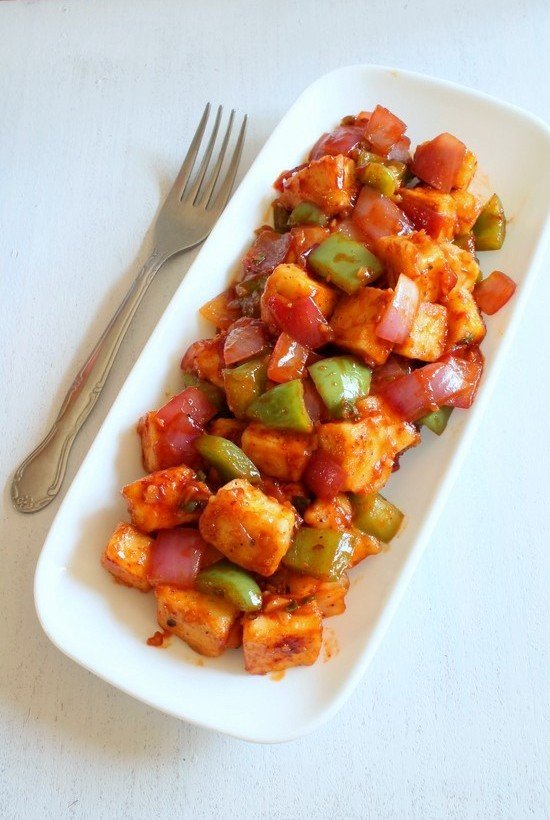
Common Mistakes to Avoid
1. Overcooking the Paneer: Paneer is a delicate dairy product and can quickly become tough and rubbery if overcooked. To retain its soft, melt-in-the-mouth texture, always fry the paneer just until it turns light golden on all sides. Keep a close eye while cooking — once it begins to develop a slight golden crust, remove it immediately from the pan. Over-frying not only alters the texture but also takes away from the dish’s freshness and appeal.
2. Soggy Vegetables: A key characteristic of any Indo-Chinese dish is the vibrant crunch of stir-fried vegetables. Avoid cooking the onions and capsicum for too long, or they will lose their bite and become limp. Use high heat and quick stirring techniques to sear the veggies while preserving their color, crunch, and nutrients. The vegetables should remain slightly undercooked and crisp to contrast with the soft paneer.
3. Add sauces together, not one by one. Pre-mixing ensures even blending, avoids overcooked veggies, and keeps the stir-fry texture perfect.
4. Skipping the Cornflour Batter Coating: The light coating of cornflour and maida (all-purpose flour) plays a vital role in achieving the perfect restaurant-style paneer texture. This coating helps in getting a slightly crisp exterior that holds up well when tossed in sauce. Skipping this step or using too much water in the batter can result in soggy, unappealing paneer cubes. Stick to a thick batter that clings well to each piece for that authentic touch.
